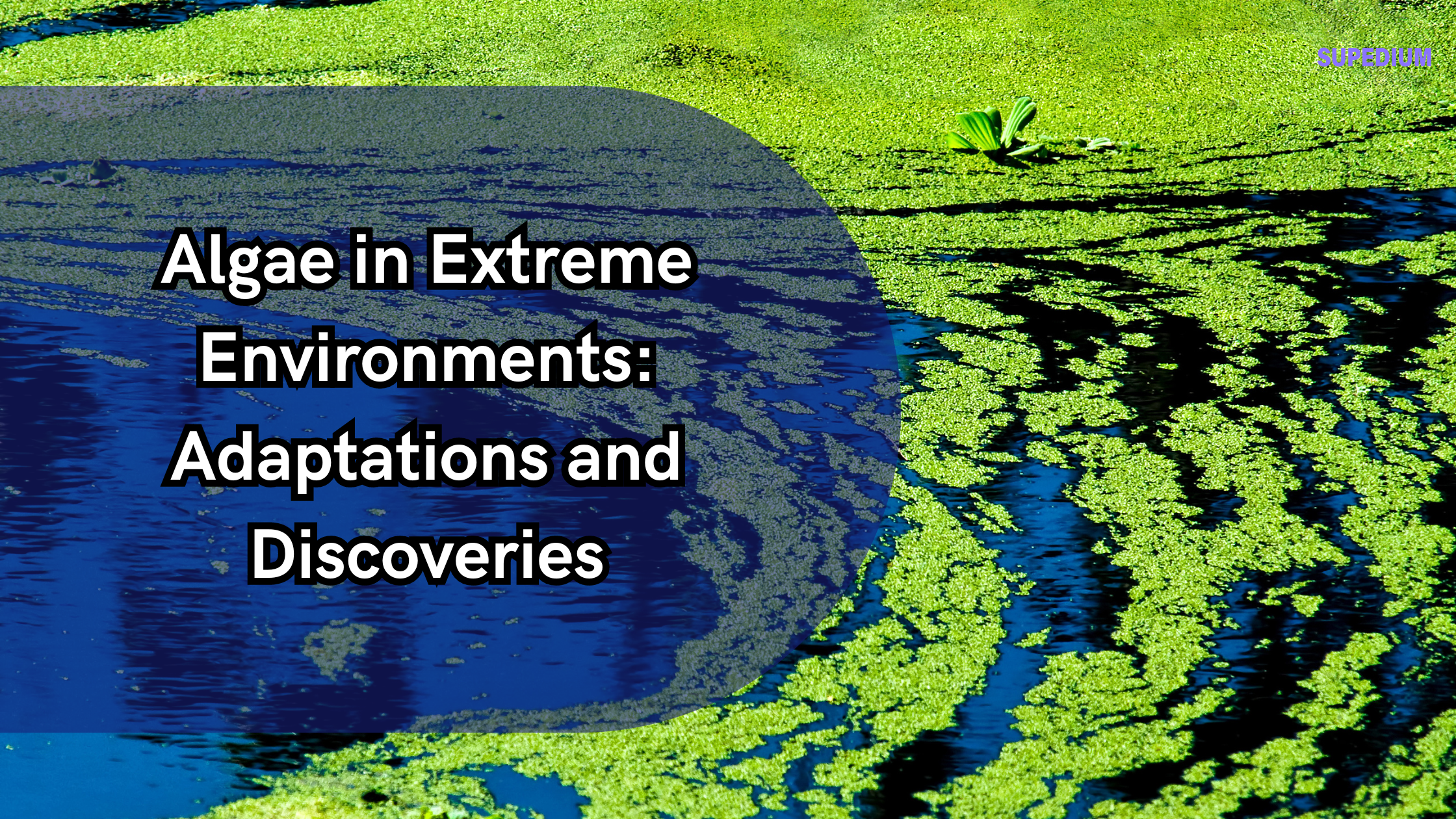Table of Contents
![]()
Introduction
Algae are a diverse group of photosynthetic organisms that play a crucial role in various ecosystems, from oceans to freshwater bodies. These organisms are not only pivotal in primary production but also contribute to nutrient cycling and serve as the base of many aquatic food webs. Algae’s ability to thrive in a range of environments makes them fascinating subjects of study, particularly when they inhabit extreme conditions. Extreme environments are characterized by conditions that are challenging for most life forms, including extreme temperatures, salinities, pH levels, radiation, and desiccation. Understanding how algae adapt to these harsh conditions provides insights into their resilience and potential applications in science and industry.
Types of Extreme Environments
Extreme Temperatures
Algae living in extreme temperatures can be found in both hot and cold environments. In thermal springs and hydrothermal vents, algae such as Cyanidium caldarium exhibit remarkable heat tolerance. These extremophiles possess unique adaptations allowing them to survive temperatures that can exceed 70°C (158°F). In contrast, psychrophilic algae, like Chlamydomonas nivalis, thrive in polar regions and high-altitude environments where temperatures can drop below freezing. Their adaptations enable them to maintain cellular integrity and metabolic activity in frigid conditions.
Extreme Salinities
Hyper-saline environments, such as salt flats and salt ponds, challenge organisms with high salt concentrations. Algae like Dunaliella salina are well-adapted to these conditions, with mechanisms to balance internal osmotic pressure and avoid dehydration. Similarly, marine algae can adjust to varying salinities, showcasing their adaptability across different aquatic habitats.
Extreme pH Levels
Algae in acidic environments, such as acid mine drainage sites, exhibit unique adaptations to survive low pH levels. Conversely, alkaline environments like soda lakes are home to alkaliphilic algae, which thrive in highly alkaline conditions. These algae have evolved mechanisms to regulate their internal pH and maintain enzyme function under extreme pH conditions.
Extreme Radiation
High UV radiation environments, such as deserts and high-altitude regions, present significant challenges for algae. They have developed protective pigments, such as carotenoids, to shield themselves from harmful UV rays. Similarly, in high ionizing radiation environments, such as those near nuclear reactors, algae like Chlorella demonstrate remarkable resistance to radiation, making them subjects of interest for studies on radiation resistance.
Extreme Desiccation
Arid environments and conditions of extreme drought pose challenges related to water scarcity. Algae in deserts have adapted by developing mechanisms to minimize water loss and tolerate desiccation. Some algae can form spores or cysts that remain dormant until conditions improve, allowing them to survive prolonged periods without water.
Adaptations of Algae in Extreme Environments
Physiological Adaptations
Physiological adaptations of algae to extreme environments include mechanisms for thermotolerance and cryotolerance. Heat-adapted algae often have modified proteins and enzymes that remain functional at high temperatures, while cold-adapted algae have membranes that maintain fluidity at low temperatures. Osmotic regulation is another critical adaptation, with algae in hyper-saline environments using specialized ion pumps and compatible solutes to balance internal osmotic pressure. pH regulation is also crucial, with algae in acidic or alkaline environments employing mechanisms to stabilize their internal pH and protect cellular functions.
Morphological Adaptations
Morphological adaptations include structural modifications to withstand harsh conditions. Algae in extreme environments may develop thicker cell walls, mucilaginous sheaths, or specialized structures to protect against desiccation, radiation, and extreme temperatures. These adaptations help maintain cellular integrity and function in challenging conditions.
Biochemical Adaptations
Biochemical adaptations involve the production of stress-related proteins and protective pigments. Heat shock proteins, for instance, help refold damaged proteins and prevent cellular damage under stress. Protective pigments, such as carotenoids and phycobiliproteins, shield algae from UV radiation and oxidative damage. Antioxidant systems, including enzymes like superoxide dismutase and catalase, play a crucial role in mitigating oxidative stress and repairing cellular damage.
Behavioral Adaptations
Behavioral adaptations include migration and spatial distribution strategies to avoid extreme conditions. Some algae can migrate to more favorable microhabitats or alter their growth patterns based on environmental conditions. Additionally, many algae can form resting stages or spores that allow them to survive adverse conditions and resume growth when conditions improve.
Discoveries and Research in Extreme Algae
Historical Discoveries
Research on algae in extreme environments has a rich history, with early studies revealing the remarkable resilience of these organisms. Pioneering work identified key species and their adaptations, laying the foundation for modern extremophile research. These early discoveries highlighted the potential for studying extreme algae as models for understanding resilience and adaptation.
Recent Advances
Recent advances in molecular biology and genomics have provided deeper insights into the adaptations of extreme algae. Sequencing technologies have revealed the genetic basis of stress responses and metabolic pathways that enable survival in extreme conditions. Studies have also focused on the synthesis of protective compounds and the regulation of stress-related genes, enhancing our understanding of how these algae manage extreme environments.
Novel Applications
The unique properties of extreme algae have led to novel applications in biotechnology and environmental science. For example, algae with high stress tolerance are being explored for biofuel production due to their ability to thrive in harsh conditions. Additionally, extremophilic algae are used in bioremediation efforts to clean up polluted environments, leveraging their resilience to remove contaminants. They also serve as indicators of environmental changes, providing valuable information on climate change and ecosystem health.
Case Studies
Algae in Thermal Springs
Thermophilic algae, such as Cyanidium caldarium, thrive in thermal springs with temperatures exceeding 70°C. These algae exhibit unique adaptations, such as heat-stable enzymes and proteins, which allow them to maintain cellular functions and survive in extreme heat. Research on these organisms has provided insights into protein stability and heat resistance mechanisms.
Algae in Arctic and Antarctic Regions
Psychrophilic algae, like Chlamydomonas nivalis, are adapted to the cold, dark conditions of polar regions. These algae possess antifreeze proteins and specialized cellular structures to prevent ice formation and maintain metabolic activity in freezing temperatures. Studies on these algae contribute to our understanding of cold adaptation and climate resilience.
Algae in Hyper-saline Environments
Halophilic algae, such as Dunaliella salina, are well-adapted to hyper-saline environments. These algae use specialized osmotic regulation mechanisms, including the synthesis of compatible solutes, to maintain cellular function in high salt concentrations. Research on halophilic algae offers insights into salt tolerance and potential applications in saline agriculture and biotechnology.
Algae in Acidic and Alkaline Environments
Acidophilic algae, like Cyanidium caldarium, and alkaliphilic algae, such as Spirulina, thrive in extreme pH environments. Acidophilic algae have developed mechanisms to cope with low pH, such as acid-resistant enzymes and proton pumps. Alkaliphilic algae, on the other hand, use mechanisms to maintain intracellular pH and enzyme activity in alkaline conditions. These studies enhance our understanding of pH adaptation and its implications for environmental management.
Implications and Future Directions
Implications for Ecosystem Health
Extreme algae play a critical role in their ecosystems, contributing to nutrient cycling and primary production in extreme environments. Understanding their adaptations helps predict how these ecosystems might respond to environmental changes, such as climate change and pollution. Extreme algae also serve as indicators of ecosystem health, providing valuable information on the impact of environmental stressors.
Future Research Directions
Future research on extreme algae will likely focus on exploring their genetic and biochemical adaptations in greater detail. Advances in sequencing and bioinformatics will enable the identification of novel stress response mechanisms and potential applications in biotechnology. Research will also continue to investigate the role of extreme algae in ecosystem dynamics and their potential for environmental and industrial applications.
Applications in Science and Industry
The unique properties of extreme algae offer promising applications in various fields. Their resilience to harsh conditions makes them valuable for developing biofuels and other biotechnological products. Additionally, their ability to survive in polluted environments provides opportunities for bioremediation and environmental restoration efforts. Continued research will explore these applications and unlock new potential for extreme algae in science and industry.
Conclusion
Algae in extreme environments represent a remarkable example of life’s ability to adapt to challenging conditions. Their diverse adaptations, from physiological and biochemical to morphological and behavioral, enable them to thrive in some of the harshest environments on Earth. The discoveries and research on extreme algae not only enhance our understanding of their resilience but also offer valuable insights and applications in biotechnology and environmental science. As research progresses, the potential for new discoveries and innovations in the field of extremophilic algae continues to grow, highlighting the importance of these remarkable organisms in both science and industry.
Share This





Be the first to comment